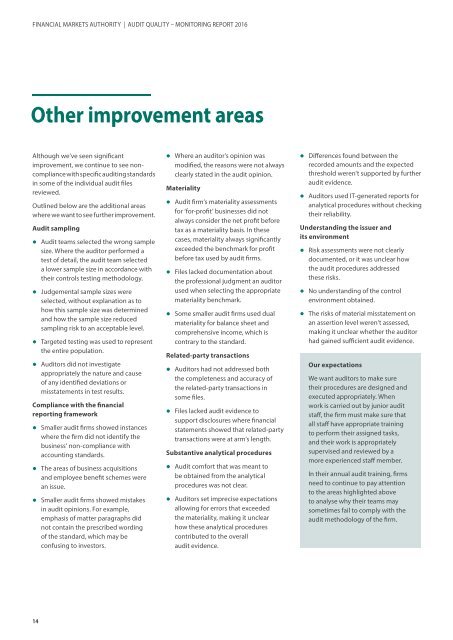Audit Quality – Monitoring Report
161128-Audit-Quality-Monitoring-report-2016
161128-Audit-Quality-Monitoring-report-2016
Create successful ePaper yourself
Turn your PDF publications into a flip-book with our unique Google optimized e-Paper software.
FINANCIAL MARKETS AUTHORITY | AUDIT QUALITY <strong>–</strong> MONITORING REPORT 2016<br />
Other improvement areas<br />
Although we’ve seen significant<br />
improvement, we continue to see noncompliance<br />
with specific auditing standards<br />
in some of the individual audit files<br />
reviewed.<br />
Outlined below are the additional areas<br />
where we want to see further improvement.<br />
<strong>Audit</strong> sampling<br />
• <strong>Audit</strong> teams selected the wrong sample<br />
size. Where the auditor performed a<br />
test of detail, the audit team selected<br />
a lower sample size in accordance with<br />
their controls testing methodology.<br />
• Judgemental sample sizes were<br />
selected, without explanation as to<br />
how this sample size was determined<br />
and how the sample size reduced<br />
sampling risk to an acceptable level.<br />
• Targeted testing was used to represent<br />
the entire population.<br />
• <strong>Audit</strong>ors did not investigate<br />
appropriately the nature and cause<br />
of any identified deviations or<br />
misstatements in test results.<br />
Compliance with the financial<br />
reporting framework<br />
• Smaller audit firms showed instances<br />
where the firm did not identify the<br />
business’ non-compliance with<br />
accounting standards.<br />
• The areas of business acquisitions<br />
and employee benefit schemes were<br />
an issue.<br />
• Smaller audit firms showed mistakes<br />
in audit opinions. For example,<br />
emphasis of matter paragraphs did<br />
not contain the prescribed wording<br />
of the standard, which may be<br />
confusing to investors.<br />
• Where an auditor’s opinion was<br />
modified, the reasons were not always<br />
clearly stated in the audit opinion.<br />
Materiality<br />
• <strong>Audit</strong> firm’s materiality assessments<br />
for ‘for-profit’ businesses did not<br />
always consider the net profit before<br />
tax as a materiality basis. In these<br />
cases, materiality always significantly<br />
exceeded the benchmark for profit<br />
before tax used by audit firms.<br />
• Files lacked documentation about<br />
the professional judgment an auditor<br />
used when selecting the appropriate<br />
materiality benchmark.<br />
• Some smaller audit firms used dual<br />
materiality for balance sheet and<br />
comprehensive income, which is<br />
contrary to the standard.<br />
Related-party transactions<br />
• <strong>Audit</strong>ors had not addressed both<br />
the completeness and accuracy of<br />
the related-party transactions in<br />
some files.<br />
• Files lacked audit evidence to<br />
support disclosures where financial<br />
statements showed that related-party<br />
transactions were at arm’s length.<br />
Substantive analytical procedures<br />
• <strong>Audit</strong> comfort that was meant to<br />
be obtained from the analytical<br />
procedures was not clear.<br />
• <strong>Audit</strong>ors set imprecise expectations<br />
allowing for errors that exceeded<br />
the materiality, making it unclear<br />
how these analytical procedures<br />
contributed to the overall<br />
audit evidence.<br />
• Differences found between the<br />
recorded amounts and the expected<br />
threshold weren't supported by further<br />
audit evidence.<br />
• <strong>Audit</strong>ors used IT-generated reports for<br />
analytical procedures without checking<br />
their reliability.<br />
Understanding the issuer and<br />
its environment<br />
• Risk assessments were not clearly<br />
documented, or it was unclear how<br />
the audit procedures addressed<br />
these risks.<br />
• No understanding of the control<br />
environment obtained.<br />
• The risks of material misstatement on<br />
an assertion level weren’t assessed,<br />
making it unclear whether the auditor<br />
had gained sufficient audit evidence.<br />
Our expectations<br />
We want auditors to make sure<br />
their procedures are designed and<br />
executed appropriately. When<br />
work is carried out by junior audit<br />
staff, the firm must make sure that<br />
all staff have appropriate training<br />
to perform their assigned tasks,<br />
and their work is appropriately<br />
supervised and reviewed by a<br />
more experienced staff member.<br />
In their annual audit training, firms<br />
need to continue to pay attention<br />
to the areas highlighted above<br />
to analyse why their teams may<br />
sometimes fail to comply with the<br />
audit methodology of the firm.<br />
14


